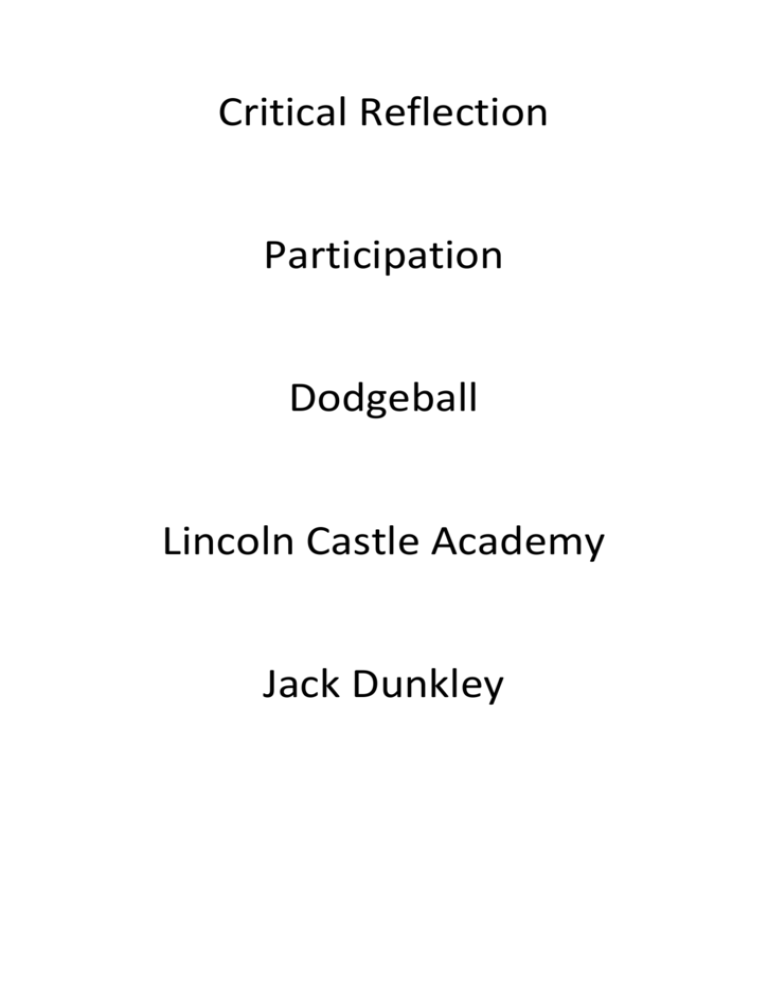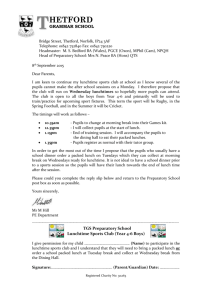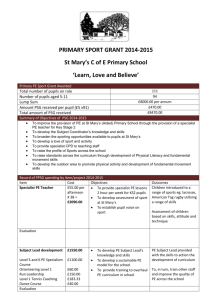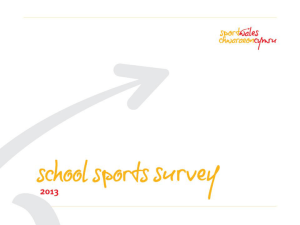Reflection - Lincoln Castle Academy - Dodgeball
advertisement

Critical Reflection Participation Dodgeball Lincoln Castle Academy Jack Dunkley Introduction As part of our module for Contemporary Issues in Physical Education, we were assigned to groups and given a sport and school to create a sports club either during lunch times or after school. Our group were given Dodgeball at the Lincoln Castle Academy. We were told to provide a series of sessions and finish with an event or festival. This essay highlights an incident which occurred during the project, how we aimed to overcome the problem and gives recommendations to why it might have occurred and what should be done in future to prevent re-occurrence. Dodgeball is a very new, up and coming sport. More leagues are being formed and more tournaments are popping up across the UK. As well as being a very social and fun activity, it is also great for fitness and can be extremely competitive. It is not a sport that is taught in many schools in PE lessons so raising awareness is vital to its growth and sustainability. During our planning we had to decide between doing a lunch time or after school club but were advised that participation in an after school club would most likely be low as pupils rely on lifts or school transport to get home from school. Therefore it was decided that our Dodgeball club would take part during lunch times once a week. The project consisted of 6 lunch-time sessions and 3 sessions taken during PE lessons. The problem that occurred and became a regular trend during the project was the level of participation. It was often the case that we had just enough pupils for matches and sometimes those of us that did not coach joined in to make up the numbers. It was also only boys that turned up for the sessions even though the club was advertised to boys and girls. Literature In the UK extracurricular PE is seen as significant in setting the foundations for lifelong participation in sport and physical activity among young people (Smith A et al 2007). Government strategies and initiatives are focused upon extending sporting opportunities for youngsters in school through the enhancement of extracurricular physical education and sports club links. Policies such as PESSCL (Physical Education and School Sport Club Links) tend to be based on a number of assumptions: (i) involvement in extracurricular PE is relatively low; (ii) schools in England and Wales have been reducing extracurricular PE in recent years; and (iii) participation diminishes substantially during the secondary years to the point that, by the time they reach school-leaving age (16 years), very few young people are taking part in extracurricular PE in the UK, (Smith A et al 2007). According to Sport England, between 1994 and 2002, opportunities for extracurricular PE improved significantly, including a steady climb in the percentage of secondary schools in England reporting an increase in the number of sports offered to pupils. A factor that may have contributed to low levels of participation may be the popularity of Dodgeball. If the club was a football or rugby club it would be much more likely that attendance would be higher. In an Oftsted report, it was stated that eleven different sports were available as extra-curricular activities in more than three-quarters of schools and in all specialist sports colleges. The sports and activities offered reflected the blend of ‘traditional’ sports (athletics, football, netball) and ‘newer’ sports, such as basketball. Dodgeball is classed as a ‘newer’ sport which may suggest why participation in a Dodgeball club might be lower than in clubs which provide sports which are seen as more ‘traditional’ activities. Penney and Harris (1997) suggested that extracurricular activities were dominated by ‘traditional team games’, had a competitive focus and were highly gendered. This gender issue was apparent within our Dodgeball lunch time club as not one girl participated in any of the 6 sessions which were provided. The only time girls joined in was in the showcase week where we went into PE classes but apart from 3, the girls played in a separate hall to the boys. In extracurricular PE across England in 2002, ‘only four sports had been participated in by more than five per cent of all pupils’: football (15 per cent), netball (7 per cent), athletics (6 per cent) and cricket (5 per cent) (Sport England, 2003). These statistics how low participation is in extracurricular sports, even with sports like football which is the most played sport in the country. In Cale’s (2000) study, it was stated by heads of PE departments in secondary schools in England that between 5% and 30% of pupils took part in regular extracurricular activities that were provided. It was suggested that the pupils in the particular schools were given the chance to take part but only a minority did. This relates to what Daley (2002) stated in that ‘most pupils are given the opportunity to participate in physical activity outside of formal physical education lessons, but many choose not to do so, or at least not on a regular basis.’ This might suggest that even though the participation levels where low, it might not be the fault of the club or how it was ran. It is simply that even when given the opportunity, pupils decide against joining clubs and extracurricular activities. Sport England (2003) reveals that participation in extracurricular PE tends to peak in or around the final year of primary schooling – with 72 per cent taking part frequently in Wales, in 2004. In the first year of secondary school (Year 7) in Wales, however, participation declined severely to 51 per cent of pupils. Subsequently, regular (weekly or more often) participation in extracurricular PE in both England and Wales displays a trend to drop as pupils move from lower through to upper school; that is from Years7–9 to Years 10–11. As the Dodgeball club was set up specifically for year 8 and 9 pupils these statistics show that it is not uncommon for pupils of this ages to choose not to partake in out of lesson time physical activity. Strategy As an attempt to overcome the issue of low participation levels, as a group we decided to provide a ‘showcase week.’ This involved taking PE lessons for year 8 and 9 classes to teach them how to play Dodgeball. In total we did this for lessons which involved some demonstrations, explanations of the rules and a series of games. Another thing we did to promote Dodgeball and our own club was bring some of the University of Lincoln Dodgeball team players along to the showcase week sessions. They gave a short demonstration of a match between themselves and a few of us got involved too. The pupils thrived upon the chance to throw balls at us as we had been the coaches and organisers for the majority of the project. It gave them an opportunity that they would not normally get in PE lessons even though it is likely they would enjoy that even more. They also talked about tactics and techniques throughout the sessions. The aim of the showcase week was to give more of the pupils, boys and girls a chance to experience Dodgeball and increase the number of participants in our final lunch time session the following week. As it tended to be the same group of boys that turned up each week to the lunch time sessions, it was in our interest to get new people to at least try out Dodgeball to see how they like it or not. The showcase week proved to work in terms of increasing participation as in the final session more pupils turned up than in any of the previous weeks. Although numbers increased it was still only boys that took part. Not one girl came to any of the lunch time sessions in the 6 weeks, which is probably because of the nature of the sport and not seen as a ‘girly’ sport which confirms gender stereotypes within sport. After our final sessions we asked 20 pupils in total to fill out a questionnaire. This yielded some interesting results which might suggest future participation in Dodgeball, these are shown in appendix A, B and C. Exactly 50% said that they would like to join a Dodgeball club or a team and 90% said that they would like to play more Dodgeball in school, either during lessons or lunch time sessions. However 75% of the group noted that they still prefer to play other sports, football being the main one highlighted. This is not surprising when looking at participation levels in sports such as football and rugby within the UK. Recommendations In future I believe that if we were to arrange the showcase week at the start of the program it will prove to be more beneficial to the levels of participation, as from the registers taken each session it did show to increase awareness and participation. Also next time I would recommend that as a group we advertised the club better. The only advertisement that we did was a few posters to put up around the school and through word of mouth. Initially we wanted to go into an assembly and a few lessons to give presentations about Dodgeball and what we had planned for the lunch time club. I would also recommend trying the club during after school hours to see whether or not more pupils turn up than in the lunch time session. It might be worth while running two sessions a week, one during lunch times and one after school so the club is accessible to pupils who cannot attend at lunch times. Finally to involve a greater sense of competition the final week could have included a tournament with prizes and awards. This could have been done either within the chosen school or it could have involved another school to compete against. As numbers were fairly low most weeks it was difficult to create this sort of atmosphere because it was always similar teams playing against each other for the majority of the sessions. Conclusion Overall I felt that our project was successful and from our questionnaire results the majority of pupils who came to the sessions enjoyed playing Dodgeball on a regular basis. The bar charts in appendix D and E show score from 1 to 5 relating to how much the pupils enjoyed the Dodgeball sessions and the showcase week with the involvement of the University team. As stated in the recommendations a more extensive advertising strategy may have proven to increase the popularity of the club and I final event or tournament may have also helped with the issue of participation levels. References Cale, L. (2000) ‘Physical Activity Promotion in Secondary Schools’, European Physical Education Review 6(1): 71–90. Daley, A. (2002) ‘Extra-Curricular Physical Activities and Physical Self-Perceptions in British 14–15 year-old Male and Female Adolescents’, European Physical Education Review 8(1): 37–50. Penney, D. and Harris, J. (1997) ‘Extra-Curricular Physical Education: More of the Same for the More Able’, Sport, Education and Society 2(1): 41–54. Sport England (2003) Young People and Sport in England 2002. London: Sport England. Appendix A Chart to Show Potentional Participation Based on Questionnaire Results 50% 50% Yes No B A Chart to Show the Percentage who Prefer to Play Other Sports 25% Yes 75% No C A Chart Showing the Percentage who Would Like to Play More Dodgeball in School 10% Yes 90% No D A Bar Graph to Show Enjoyment Ratings 12 Total Value 10 8 6 4 2 0 1 2 3 4 5 Rating Scale E A Chart Showing Enjoyment Rates of Showcase Week 12 Total value 10 8 6 4 2 0 1 2 3 Rating Scale 4 5






